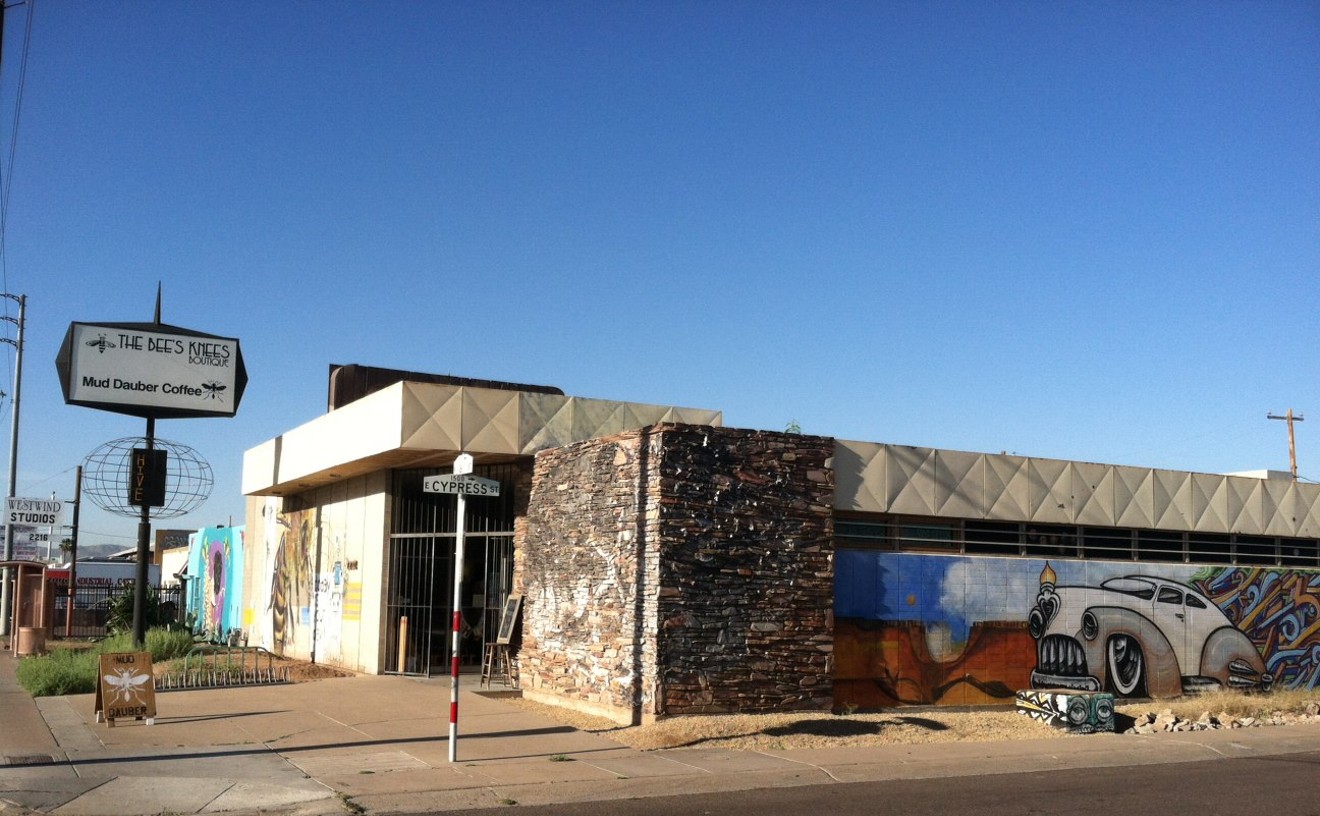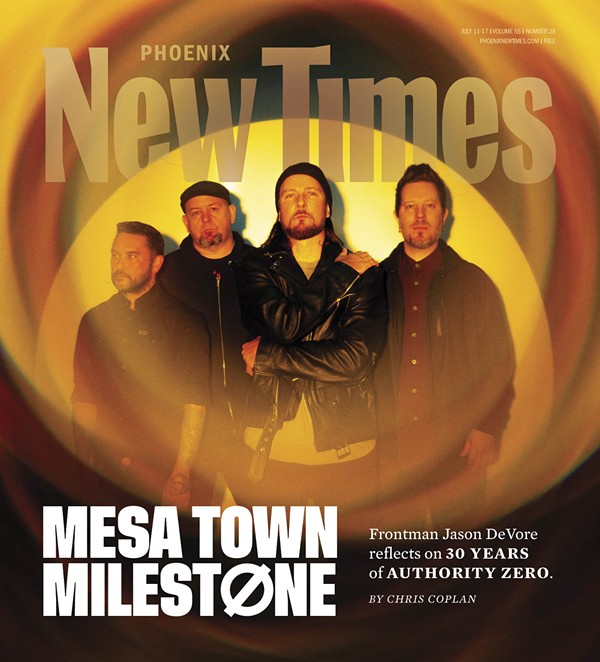While others seek to consolidate the Phoenix arts scene into areas dubbed art districts, artists and married couple Joel Coplin and Jo-Ann Lowney are expanding the boundaries of Phoenix's evolving arts landscape. They've transformed a warehouse space not far from the Arizona State Capitol into a studio and gallery, inviting community members to see both their own art and exhibits featuring works by accomplished artists who have been nurturing the downtown arts scene for decades, such as Jeff Falk, Annie Lopez, and Beth Ames Swartz. They've also planted a garden, where they enjoy talking with passersby. Coplin's studio includes a space where he often paints people he's met on nearby streets as he listens to them talk about the circumstances that have dramatically altered their lives, from losing a job to battling addiction. Gallery walls are filled with artworks that convey reverence for the natural world, as well as artworks that use humor and historical perspective to amplify human foibles.
Best New Gallery
Gallery 119 at Lowney/Coplin Studios
- 119 S. 11th Ave., Phoenix, 85007 Map
- 602-576-0338
- joelcoplinfineart.com
Best First Friday Hangout
Grand Avenue
Grand Avenue has shifted from an alternative arts destination to the main attraction on First Friday. With most creative spaces located along a single diagonal street that sits in the shadow of a giant anti-Trump billboard, it's easy to find and easy to explore by walking or cycling. Grand Avenue boasts a beautiful balance of galleries, music venues, small creative businesses, and welcoming places to eat and drink with friends. The atmosphere is casual and quirky, so people feel right at home even as they get the sense they've just landed on a wonderfully weird and wacky planet. Pinata-style art hangs from trees. Fences are dotted with art made from ribbons or old campaign signs. People gather indoors and out, talking about the art they've seen in their travels. Best of all, community events like the Grand Avenue Festival and Chalk Art Festival transform enjoying art from a solitary affair into a social adventure.
Best Art Enclave
The Hive

While the arts landscape changes all around it, The Hive continues to serve as a hub for creatives in and beyond metro Phoenix. It's anchored by Julia Fournier's vintage thrift shop, The Bee's Knees, where curated fashion, decor, and local artworks converge to envelop visitors in a cozy yet vibrant vibe. The Hive art gallery shows pieces by emerging and established artists working in mediums from needlepoint to photography. If you want to discover an artist you've never experienced before, this is the place to start. It's also home to Wasted Zine Ink Distro, and an eclectic assortment of studios and shops that showcase the quirky side of Phoenix culture. A courtyard gives artists and other community members a place to share poetry, food, music, and conversation. Add in the annual Coronado Art Show highlighting artistic neighbors, and vibrant murals dotting the space, and you can't deny this makes one hell of a second home when you just need to recharge your batteries with art and acceptance.
- 2222 N. 16th St., Phoenix, 85006 Map
- 602-254-1641
- hivephx.com
Best Community Art Space
The Sagrado Galleria
When people converge on The Sagrado Galleria, opened by Sam Gomez in south Phoenix in 2016, it feels like a family reunion. Old friends gather and new faces join in, creating an aura of joy and acceptance that reveals this is far more than a traditional art gallery. Gatherings often include food, indigenous music and dance, and presentations about cultural roots. Works by some of Phoenix's most revered artists share space with works by young creatives, all embraced as reflections of shared humanity and mutual responsibility for transforming the world through creativity. The gallery also engages youth and other artists in projects ranging from murals to architectural designs for public spaces, blending art and activism as a means of creating social change. Instead of nurturing only artists, The Sagrado nurtures community.
- 6437 S. Central Ave., Phoenix,, 85004 Map
- 602-413-3357
- wwwthesagrado.com
Best Hidden Art Space
Millet House
There's nothing like stumbling onto an arts space that's a bit off the beaten path, then discovering that it's home to some amazing creativity. The Millet House sits on a peaceful neighborhood street not far from Mesa Arts Center, quietly offering a rich assortment of experiences that blend art and community. The adobe mud brick house was built around 1940. Today, two rooms are used for showing art, offering free art sessions, holding pizza parties, sharing journaling time, and more. Millet House is all about helping people on the margins by giving them a shared creative space to make and show their artwork. It's a welcoming, volunteer-run space where emerging artists connect with established artists, and people feel the power of art to transform lives. The fact that Millet House is tucked away makes it even more delightful when you discover the many treasures it holds.
- 440 W. 1st St., Mesa, 85201 Map
- 949-981-3802
- themillethouse.com
Best Art Conversations
Crossfade Lab
CALA Alliance has been bringing art conversations out of traditional art space and into community venues, giving people with diverse backgrounds and interests new ways to spend time together inspired by mutual respect and the power of sharing stories. During a series of Crossfade Labs moderated by creative Josh Kun at Crescent Ballroom, community members have experienced facilitated conversations between artists working in multiple genres, and created their own conversations around issues including immigration, queer experience, and cultural appropriation. Together, Crossfade Lab participants are forging new, intersecting pathways for conversations, helping people envision fresh ways of creating, listening, and sharing both personal and collective stories, all with an eye to creating community action infused with love and justice.
Best Permanent Public Art
One-Eyed Jack by John Randall Nelson
Love it or hate it, John Randall Nelson's white jackrabbit standing 26 feet tall is a conversation-starter. It's also a playful marker for a part of Old Town Scottsdale once considered a thriving arts district, where bars and retail shops now far outnumber galleries. The metal sculpture calls to mind Lewis Carroll's fictional white rabbit and stories he penned about a girl named Alice. Where others fear a friendly wink at psychedelic drugs, we embrace the perfect symbol for a city wrestling with its own identity. Scottsdale may be perpetually falling through its own looking glass, but at least it has a monumental work of art to inspire greater imagination along the journey. Unlike the myriad horse sculptures placed around Old Town, One-Eyed Jack is a nod to the city's future rather than its past.
Best Temporary Public Art
IN FLUX Cycle 8
A bevy of large beaded creatures by Christy Puetz sit near the entrance to the children's section of Burton Barr Central Library, where a trio of Daniel Funkhouser's transparent trees in vibrant colors stand guard on another floor. They're just two of 10 artworks created for the latest iteration of this arts collaboration, which spans several cities. The temporary artworks are placed in public places, where people delight in stumbling across them. Kyllan Maney transformed exterior walls for a Tempe arts center using fractured spiral patterns drawn on maps. Steven Torres added whimsy to a Scottsdale neighborhood with a giant yellow steampunk-style seahorse. Mary Shindell brightened Glendale City Hall with several colorful acrylic cylinders wrapped with desert flora and fauna. All the installations reveal the talent in our midst, and highlight the role of art in creating vibrant communities.
Best Immigration Art
"Sangre Sudor y Amor: Hunger for the American Dream" by Janet Diaz
Four rows of dirt planted with strawberries anchored this exhibition by Mexican-American artist Janet Diaz, who returned to her hometown of Salinas, California, to gather the materials used in this compelling art show. Gallery visitors smelled the dirt and felt the humidity of watered plants, as they might while working hot days in a California field. Diaz also used sound, video, and portraits of migrants who work the strawberry fields, making visible the many people at the heart of American life whose efforts go largely unnoticed. Her portraits of migrants were hung high on the gallery walls, so those who normally look down on them would gaze up to them instead. Here, the artist made palpable the rigors of working in the field, while prompting viewers to embrace the humanity of migrants.
- 605 E. Grant St, Phoenix, 85004 Map
- 480-965-7044
- art.asu.edu/gallery/step/
Best Neon Artist
Daniel Funkhouser
Don't call it a glow-up — Daniel Funkhouser has been shining for years. An artist with a knack for crafting whimsical installations and androgynous self-portraits, Funkhouser is one of the Valley's most forward-thinking and prolific creators. While he creates in a large variety of mediums, one constant in his body of work is neon. Funkhouser knows how to paint with light. He's created (literally) brilliant neon pieces for the annual Chaos Theory group shows, pieces that are both inviting and menacing, shedding the kind of sultry noir neon glow you'd expect to see in a David Lynch film. Bright neon colors and tones give his photographs a garish, lurid energy — like they're snapshots from some alternate dimension where Kenny Scharf designed everything. When it comes to lighting up a room, nobody does it better than Funkhouser.




